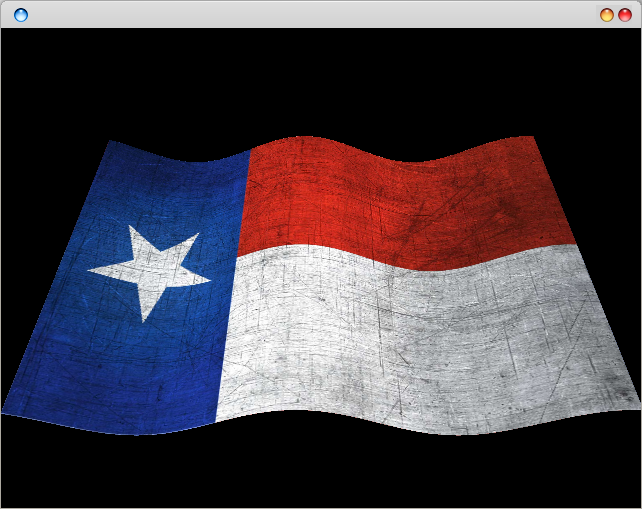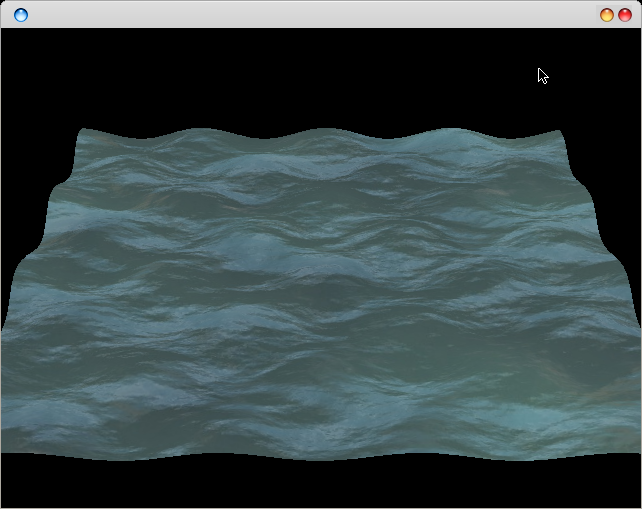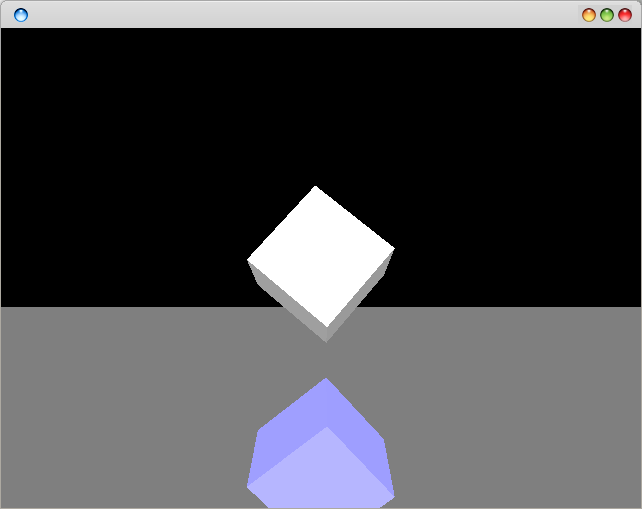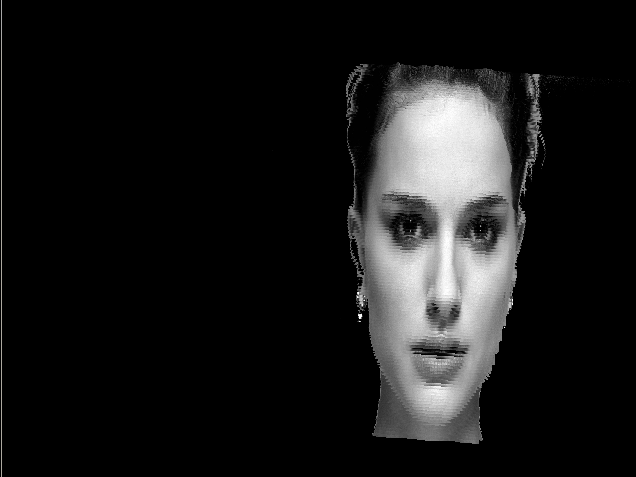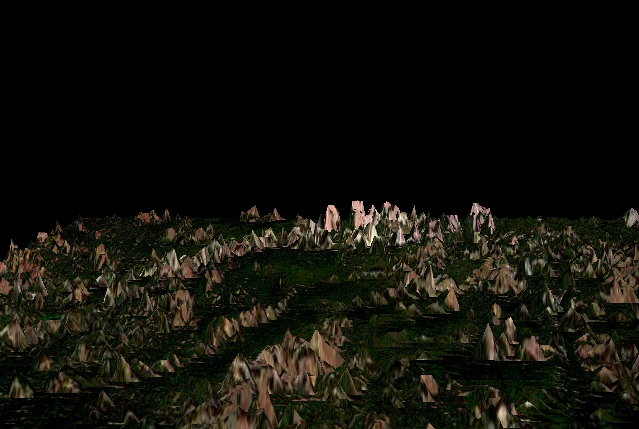Lesson 2: Maze
We have extended the previous tutorial to draw a nice looking maze. We have defined a matrix A of NxM with the elements {0,1}. If an element is {1} a cube will be placed, if an element is {0} nothing will happen. Thus, we define the matrix as:
int maze[] = { 1,1,1,1,1,1,1,1,
1,0,0,0,0,0,0,1,
1,0,1,1,0,1,0,1,
1,0,1,0,0,1,1,1,
0,0,1,1,0,0,0,0,
1,0,0,1,0,1,1,1,
1,0,0,0,0,0,0,1,
1,0,1,1,1,1,0,1,
1,0,0,0,0,0,0,1,
1,1,1,1,1,1,1,1
};
We have moved the cube drawing into a seperate function, in order to call it in a loop. The function is identical to the code of the previous tutorial:
void drawCube()
{
/* Select Our Texture */
glBindTexture( GL_TEXTURE_2D, texture[0] );
/*
* Draw the cube. A cube consists of six quads, with four coordinates (glVertex3f)
* per quad.
*
*/
glBegin(GL_QUADS);
/* Front Face */
glTexCoord2f( 0.0f, 1.0f ); glVertex3f( -1.0f, -1.0f, 1.0f );
glTexCoord2f( 1.0f, 1.0f ); glVertex3f( 1.0f, -1.0f, 1.0f );
glTexCoord2f( 1.0f, 0.0f ); glVertex3f( 1.0f, 1.0f, 1.0f );
glTexCoord2f( 0.0f, 0.0f ); glVertex3f( -1.0f, 1.0f, 1.0f );
/* Back Face */
glTexCoord2f( 0.0f, 0.0f ); glVertex3f( -1.0f, -1.0f, -1.0f );
glTexCoord2f( 0.0f, 1.0f ); glVertex3f( -1.0f, 1.0f, -1.0f );
glTexCoord2f( 1.0f, 1.0f ); glVertex3f( 1.0f, 1.0f, -1.0f );
glTexCoord2f( 1.0f, 0.0f ); glVertex3f( 1.0f, -1.0f, -1.0f );
/* Top Face */
glTexCoord2f( 1.0f, 1.0f ); glVertex3f( -1.0f, 1.0f, -1.0f );
glTexCoord2f( 1.0f, 0.0f ); glVertex3f( -1.0f, 1.0f, 1.0f );
glTexCoord2f( 0.0f, 0.0f ); glVertex3f( 1.0f, 1.0f, 1.0f );
glTexCoord2f( 0.0f, 1.0f ); glVertex3f( 1.0f, 1.0f, -1.0f );
/* Bottom Face */
/* Top Right Of The Texture and Quad */
glTexCoord2f( 0.0f, 1.0f ); glVertex3f( -1.0f, -1.0f, -1.0f );
glTexCoord2f( 1.0f, 1.0f ); glVertex3f( 1.0f, -1.0f, -1.0f );
glTexCoord2f( 1.0f, 0.0f ); glVertex3f( 1.0f, -1.0f, 1.0f );
glTexCoord2f( 0.0f, 0.0f ); glVertex3f( -1.0f, -1.0f, 1.0f );
/* Right face */
glTexCoord2f( 0.0f, 0.0f ); glVertex3f( 1.0f, -1.0f, -1.0f );
glTexCoord2f( 0.0f, 1.0f ); glVertex3f( 1.0f, 1.0f, -1.0f );
glTexCoord2f( 1.0f, 1.0f ); glVertex3f( 1.0f, 1.0f, 1.0f );
glTexCoord2f( 1.0f, 0.0f ); glVertex3f( 1.0f, -1.0f, 1.0f );
/* Left Face */
glTexCoord2f( 1.0f, 0.0f ); glVertex3f( -1.0f, -1.0f, -1.0f );
glTexCoord2f( 0.0f, 0.0f ); glVertex3f( -1.0f, -1.0f, 1.0f );
glTexCoord2f( 0.0f, 1.0f ); glVertex3f( -1.0f, 1.0f, 1.0f );
glTexCoord2f( 1.0f, 1.0f ); glVertex3f( -1.0f, 1.0f, -1.0f );
glEnd( );
}
To draw the matrix we use this code:
int yc = 0;
int xc = 0;
for (yc = 0; yc
Where 8 is the width of the matrix and 10 the height of the matrix, 2.0f is the size of the cube. You may want to define constant variables instead of magic numbers there, but for an example this is not a problem 
The full code and texture (from the game crack attack!) are shown below:
/*
* OpenGL Textured Cube
* https://talkera.org.cp-in-1.webhostbox.net/opengl/
*
* Compilation trough:
* gcc cube.c -lglut -lGL -lGLU -lSDL
*
*/
#include
#include
#include
#include
#include "SDL/SDL.h"
/* screen width, height, and bit depth */
#define SCREEN_WIDTH 640
#define SCREEN_HEIGHT 480
#define SCREEN_BPP 16
/* Setup useful booleans */
#define TRUE 1
#define FALSE 0
/* This is our SDL surface */
SDL_Surface *surface;
/* Used for rotating the cube */
GLfloat rotationXaxis;
GLfloat rotationYaxis;
GLfloat rotationZaxis;
/* Storage For One Texture ( NEW ) */
GLuint texture[1];
/* Release resources and quit */
void Quit( int returnCode ) {
SDL_Quit( );
exit( returnCode );
}
/* Loads in a bitmap as a GL texture */
int LoadGLTextures( ) {
int Status = FALSE;
/* Create storage space for the texture */
SDL_Surface *TextureImage[1];
/* Load The Bitmap into Memory */
if ((TextureImage[0] = SDL_LoadBMP("data/cube.bmp"))) {
Status = TRUE;
glGenTextures( 1, &texture[0] );
glBindTexture( GL_TEXTURE_2D, texture[0] );
glTexImage2D( GL_TEXTURE_2D, 0, 3, TextureImage[0]->w,
TextureImage[0]->h, 0, GL_BGR,
GL_UNSIGNED_BYTE, TextureImage[0]->pixels );
glTexParameteri( GL_TEXTURE_2D, GL_TEXTURE_MIN_FILTER, GL_LINEAR );
glTexParameteri( GL_TEXTURE_2D, GL_TEXTURE_MAG_FILTER, GL_LINEAR );
}
/* Free up some memory */
if ( TextureImage[0] )
SDL_FreeSurface( TextureImage[0] );
return Status;
}
/* function to reset our viewport after a window resize */
int resizeWindow( int width, int height ) {
/* Height / width ration */
GLfloat ratio;
/* Protect against a divide by zero */
if ( height == 0 )
height = 1;
ratio = ( GLfloat )width / ( GLfloat )height;
/* Setup our viewport. */
glViewport( 0, 0, ( GLint )width, ( GLint )height );
/*
* change to the projection matrix and set
* our viewing volume.
*/
glMatrixMode( GL_PROJECTION );
glLoadIdentity( );
/* Set our perspective */
gluPerspective( 45.0f, ratio, 0.1f, 100.0f );
/* Make sure we're chaning the model view and not the projection */
glMatrixMode( GL_MODELVIEW );
/* Reset The View */
glLoadIdentity( );
return( TRUE );
}
/* function to handle key press events */
void handleKeyPress( SDL_keysym *keysym )
{
switch ( keysym->sym )
{
case SDLK_ESCAPE:
/* ESC key was pressed */
Quit( 0 );
break;
case SDLK_F1:
/* F1 key was pressed
* this toggles fullscreen mode
*/
SDL_WM_ToggleFullScreen( surface );
break;
default:
break;
}
return;
}
/* OpenGL initialization function */
int initGL( GLvoid )
{
/* Load in the texture */
if ( !LoadGLTextures( ) )
return FALSE;
/* Enable Texture Mapping ( NEW ) */
glEnable( GL_TEXTURE_2D );
/* Enable smooth shading */
glShadeModel( GL_SMOOTH );
/* Set the background black */
glClearColor( 0.0f, 0.0f, 0.0f, 0.5f );
/* Depth buffer setup */
glClearDepth( 1.0f );
/* Enables Depth Testing */
glEnable( GL_DEPTH_TEST );
/* The Type Of Depth Test To Do */
glDepthFunc( GL_LEQUAL );
/* Really Nice Perspective Calculations */
glHint( GL_PERSPECTIVE_CORRECTION_HINT, GL_NICEST );
return( TRUE );
}
void drawCube()
{
/* Select Our Texture */
glBindTexture( GL_TEXTURE_2D, texture[0] );
/*
* Draw the cube. A cube consists of six quads, with four coordinates (glVertex3f)
* per quad.
*
*/
glBegin(GL_QUADS);
/* Front Face */
glTexCoord2f( 0.0f, 1.0f ); glVertex3f( -1.0f, -1.0f, 1.0f );
glTexCoord2f( 1.0f, 1.0f ); glVertex3f( 1.0f, -1.0f, 1.0f );
glTexCoord2f( 1.0f, 0.0f ); glVertex3f( 1.0f, 1.0f, 1.0f );
glTexCoord2f( 0.0f, 0.0f ); glVertex3f( -1.0f, 1.0f, 1.0f );
/* Back Face */
glTexCoord2f( 0.0f, 0.0f ); glVertex3f( -1.0f, -1.0f, -1.0f );
glTexCoord2f( 0.0f, 1.0f ); glVertex3f( -1.0f, 1.0f, -1.0f );
glTexCoord2f( 1.0f, 1.0f ); glVertex3f( 1.0f, 1.0f, -1.0f );
glTexCoord2f( 1.0f, 0.0f ); glVertex3f( 1.0f, -1.0f, -1.0f );
/* Top Face */
glTexCoord2f( 1.0f, 1.0f ); glVertex3f( -1.0f, 1.0f, -1.0f );
glTexCoord2f( 1.0f, 0.0f ); glVertex3f( -1.0f, 1.0f, 1.0f );
glTexCoord2f( 0.0f, 0.0f ); glVertex3f( 1.0f, 1.0f, 1.0f );
glTexCoord2f( 0.0f, 1.0f ); glVertex3f( 1.0f, 1.0f, -1.0f );
/* Bottom Face */
/* Top Right Of The Texture and Quad */
glTexCoord2f( 0.0f, 1.0f ); glVertex3f( -1.0f, -1.0f, -1.0f );
glTexCoord2f( 1.0f, 1.0f ); glVertex3f( 1.0f, -1.0f, -1.0f );
glTexCoord2f( 1.0f, 0.0f ); glVertex3f( 1.0f, -1.0f, 1.0f );
glTexCoord2f( 0.0f, 0.0f ); glVertex3f( -1.0f, -1.0f, 1.0f );
/* Right face */
glTexCoord2f( 0.0f, 0.0f ); glVertex3f( 1.0f, -1.0f, -1.0f );
glTexCoord2f( 0.0f, 1.0f ); glVertex3f( 1.0f, 1.0f, -1.0f );
glTexCoord2f( 1.0f, 1.0f ); glVertex3f( 1.0f, 1.0f, 1.0f );
glTexCoord2f( 1.0f, 0.0f ); glVertex3f( 1.0f, -1.0f, 1.0f );
/* Left Face */
glTexCoord2f( 1.0f, 0.0f ); glVertex3f( -1.0f, -1.0f, -1.0f );
glTexCoord2f( 0.0f, 0.0f ); glVertex3f( -1.0f, -1.0f, 1.0f );
glTexCoord2f( 0.0f, 1.0f ); glVertex3f( -1.0f, 1.0f, 1.0f );
glTexCoord2f( 1.0f, 1.0f ); glVertex3f( -1.0f, 1.0f, -1.0f );
glEnd( );
}
int maze[] = { 1,1,1,1,1,1,1,1,
1,0,0,0,0,0,0,1,
1,0,1,1,0,1,0,1,
1,0,1,0,0,1,1,1,
0,0,1,1,0,0,0,0,
1,0,0,1,0,1,1,1,
1,0,0,0,0,0,0,1,
1,0,1,1,1,1,0,1,
1,0,0,0,0,0,0,1,
1,1,1,1,1,1,1,1
};
/* Here goes our drawing code */
int drawGLScene( GLvoid )
{
/* Clear The Screen And The Depth Buffer */
glClear( GL_COLOR_BUFFER_BIT | GL_DEPTH_BUFFER_BIT );
/* Move Into The Screen 5 Units */
glLoadIdentity( );
glTranslatef( -10.0f, -8.0f, -34.0f );
glRotatef( rotationXaxis, 0.0f, 1.0f, 0.0f);
int yc = 0;
int xc = 0;
for (yc = 0; yc hw_available )
videoFlags |= SDL_HWSURFACE;
else
videoFlags |= SDL_SWSURFACE;
/* This checks if hardware blits can be done */
if ( videoInfo->blit_hw )
videoFlags |= SDL_HWACCEL;
/* Sets up OpenGL double buffering */
SDL_GL_SetAttribute( SDL_GL_DOUBLEBUFFER, 1 );
/* get a SDL surface */
surface = SDL_SetVideoMode( SCREEN_WIDTH, SCREEN_HEIGHT, SCREEN_BPP,
videoFlags );
/* Verify there is a surface */
if ( !surface )
{
fprintf( stderr, "Video mode set failed: %s\n", SDL_GetError( ) );
Quit( 1 );
}
/* initialize OpenGL */
initGL( );
/* resize the initial window */
resizeWindow( SCREEN_WIDTH, SCREEN_HEIGHT );
/* wait for events */
while ( !done )
{
/* handle the events in the queue */
while ( SDL_PollEvent( &event ) )
{
switch( event.type )
{
case SDL_ACTIVEEVENT:
if ( event.active.gain == 0 )
isActive = FALSE;
else
isActive = TRUE;
break;
case SDL_VIDEORESIZE:
/* handle resize event */
surface = SDL_SetVideoMode( event.resize.w,
event.resize.h,
16, videoFlags );
if ( !surface )
{
fprintf( stderr, "Could not get a surface after resize: %s\n", SDL_GetError( ) );
Quit( 1 );
}
resizeWindow( event.resize.w, event.resize.h );
break;
case SDL_KEYDOWN:
/* handle key presses */
handleKeyPress( &event.key.keysym );
break;
case SDL_QUIT:
/* handle quit requests */
done = TRUE;
break;
default:
break;
}
}
/* draw the scene */
if ( isActive )
drawGLScene( );
}
/* clean ourselves up and exit */
Quit( 0 );
/* Should never get here */
return( 0 );
}
Texture:
Again compile with
gcc cube.c -lglut -lGL -lGLU -lSDL
